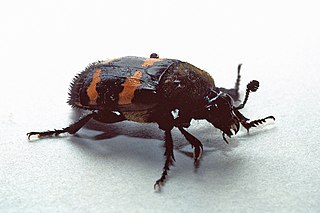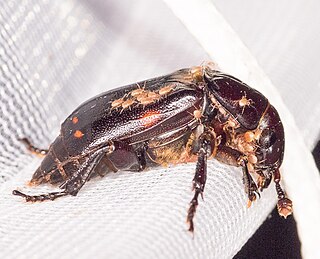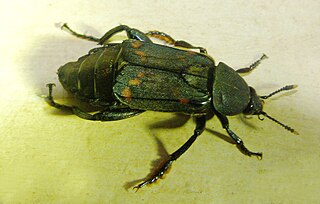
Silphidae is a family of beetles that are known commonly as large carrion beetles, carrion beetles or burying beetles. There are two subfamilies: Silphinae and Nicrophorinae. Members of Nicrophorinae are sometimes known as burying beetles or sexton beetles. The number of species is relatively small, at around two hundred. They are more diverse in the temperate region although a few tropical endemics are known. Both subfamilies feed on decaying organic matter such as dead animals. The subfamilies differ in which uses parental care and which types of carcasses they prefer. Silphidae are considered to be of importance to forensic entomologists because when they are found on a decaying body they are used to help estimate a post-mortem interval.

Burying beetles or sexton beetles, genus Nicrophorus, are the best-known members of the family Silphidae. Most of these beetles are black with red markings on the elytra (forewings). Burying beetles are true to their name—they bury the carcasses of small vertebrates such as birds and rodents as a food source for their larvae, this makes them carnivorous. They are unusual among insects in that both the male and female parents take care of the brood.

Staphylinoidea is a superfamily of beetles. It is a very large and diverse group with worldwide distribution.

Nicrophorus tomentosus is a species of burying beetle that was described by Friedrich Weber in 1801. The beetle belongs to the family Silphidae which are carrion beetles. The beetles have sensitive antennae that contain olfactory organs. Thus, the beetle can locate dead animals (carcass), and then as the name suggests, can bury them. However, unlike other burying beetles, N. tomentosus does not completely bury these brood carcasses. They instead dig a shallow hole under the carcass and cover it with leaf litter. Recognition of these beetles can be distinguished by its black color with orange markings on the wing covers (elytra).

Nicrophorus pustulatus, also known as the pustulated carrion beetle or blistered burying beetle, is a species of burying beetle that was described by Johann Karl Wilhelm Illiger in 1807. This species is native to North America. N. pustulatus exhibits unique habitat utilization and breeding behaviour relative to other members of the genus. This species may be the only described example of a true parasitoid targeting a vertebrate host.

Nicrophorus vespillo is a burying beetle described by Carl Linnaeus in his landmark 1758 10th edition of Systema Naturae. It has a paleartic distribution and is commonly found across Europe and Asia, extending from Western Europe to Mongolia.
Nicrophorus smefarka is a burying beetle described by Jirí Háva, J. Schneider & Jan Růžička in 1999.
Nicrophorus sausai is a burying beetle described by Jan Růžička, Jirí Háva and J. Schneider in 2000. It is known from Laos and northeastern India.

Nicrophorus orbicollis is a nearctic burying beetle first described by Thomas Say in 1825. It is a member of the genus Nicrophorus or sexton beetles, comprising the most common beetles in the family Silphidae. This species is a decomposer feeding on carcasses of small dead animals. N. orbicollis can be used for scientific research both medically and forensically.

The American carrion beetle is a North American beetle of the family Silphidae. It lays its eggs in, and its larvae consume, raw flesh and fungi. The larvae and adults also consume fly larvae and the larvae of other carrion beetles that compete for the same food sources as their larvae. They prefer to live in marshy and woody habitats. Necrophila americana emerge from their larval state in the early summer. The P. ashtoni cuckoo bumble bee displays close mimicry with the American carrion beetle. They are important in forensic studies because of their tendency to thrive on large carcasses.

Poecilochirus is a Holarctic genus of mites in the family Parasitidae. They are relatively large and often found on rotting corpses, where they are transported by beetles. Deuteronymphs are characterized by two orange dorsal shields and in many species a transverse band on the sternal shield. The juvenile development consists of a larval stage, protonymph, and deuteronymph, but no tritonymph. Females are smaller than males. Males guard female deuteronymphs shortly before these mate, and pairs mate venter-to-venter.

Oiceoptoma noveboracense is a member of the family Silphidae, or carrion beetles, which feed on decaying organic matter such as dead animals. Its common name is the margined carrion beetle, from the orange-red margins on the pronotum, which are helpful when identifying this species. The larva is typically light brown to red and also has vertical ridges on its thorax like the adult. This diurnal beetle can be found mainly in the spring into the fall, and it has a strong preference towards a deciduous forest habitat. The primary forensic importance of this beetle is its ability to use the succession of insect fauna to provide confirmation of postmortem intervals.

Silphinae is a subfamily of carrion beetles. There are 113 extant species of this subfamily, in two tribe and in 14 genera. It contains the following tribes and genera:

Ablattaria is a genus of carrion beetles belonging to the family Silphidae. The beetles are predators of gastropods. All species in the genus exhibit sexual dimorphism.
Oiceoptoma rugulosum is a species of carrion beetle in the family Silphidae. It is found in North America.

Oiceoptoma inaequale, the ridged carrion beetle, is a species of carrion beetle in the family Silphidae. It is found in North America.

Diamesus osculans, is a species of carrion beetle found in Sri Lanka, Indonesia, Philippines, Laos, China, Australia.

Necrophila (Deutosilpha) rufithorax, is a species of carrion beetle found in India, Nepal and Sri Lanka. The species also known to live in Laos and Thailand, but might be another species.

Oiceoptoma thoracicum, the red-breasted carrion beetle, is a species of carrion beetle in the family Silphidae. It is found in the Palearctic. As a carrion beetle, this species is a generalist that can have importance in forensic entomology. Larval survival to adulthood occurs most often if the beetles are fed pork compared to beef or chicken.

Necrodes littoralis, also known as the short sexton beetle, is a species of carrion beetle of the genus Necrodes, found in countries across Europe. As a carrion beetle, it feeds on decaying vertebrate remains and maggots. This species' feeding behaviors make it an important asset to forensic entomology.

















